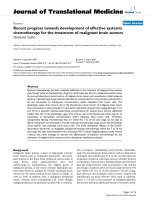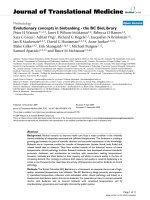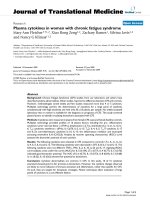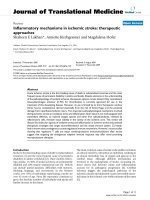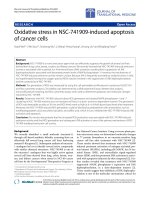Báo cáo hóa học: "Recent advances in multiuser MIMO systems" potx
Bạn đang xem bản rút gọn của tài liệu. Xem và tải ngay bản đầy đủ của tài liệu tại đây (136.23 KB, 2 trang )
EDI T O R I A L Open Access
Recent advances in multiuser MIMO systems
Rodrigo C de Lamare
1*
, Martin Haardt
2
, Michael Joham
3
, Didier Le Ruyet
4
and David J Love
5
We would like to welcome you to the Special Issue on
Recent Advances in Multiuser MIMO Systems of the
EURASIP Journal on Wireless Communications and
Networking (JWCN). This issue has collected several
research results on various aspe cts of multiuser MIMO
systems including resource allocation, precoding and
detection algorithms, limited feedback techniques and
network MIMO.
MIMO is a key technology for future wireless commu-
nication systems. By exploiting the multi-dimensional
properties of wireless channels created by multiple
transmit and receive antennas, MIMO systems can sig-
nificantly increase the channel capacity and link robust-
ness of wireless communication, and have been wide ly
adopted in many future wireless communication stan-
dards (e.g. WiMAX, 3GPP LTE, etc.). Multiuser MIMO
algorithms are recently being considered to enhance
wireless communications systems when the number of
users, or connections, are greater than one.
Multiuser MIMO systems can be broadly categorized
into MIMO broadcast channels and MIMO multiple
access channels for downlink and uplink situations,
respectively. The achievable gains of multiuser MIMO
in wireless systems are yet to be demonstrated in prac-
tice and this is currently the subject of intense research
efforts. Nevertheless, these techniques are forecast to
play a major role in the increase of spectral ef ficiency of
future wireless networks. A number of problems need
to be addressed before multiuser MIMO becomes widely
adopted. Among these problems are interference mitiga-
tion and management, resource allocation, the amount
of feedback information for precoding and coordination,
implementation and energy consumption issues, scal-
ability and coordination between access points (APs)
strategies. The idea of this special issue was to capture
recent research contribu tions and advances in multiuser
MIMO systems and their applications to wireless net-
works. We have received about 60 paper submissions
for this Special Issue by the deadline in October 2010.
After extensive and careful reviews, we accepted 19
high-quality papers that best fit with the topic of mul-
tiuser MIMO systems.
We have organized the papers into several groups
dealing with multiuser MIMO systems. The first two
papers by Duplicy et al. and Papathanassiou et al. focus
on multiuser MIMO concepts for long-term evolution
(LTE) and for the downlink of IEEE 802.16 m networks,
respectively. These papers provide an excellent overview
of the role of multiuser MIMO in modern wireless
systems.
The second group has two papers that deal with capa-
city studies. The first paper by Chen et al. investigates
the achievable rates of MIMO broadcast channels with
feedback-link capacity constraints, whereas the second
paper by Shakir et al. examines a bound on the joint
decoding capacity of Wyner Gaussian cellular MAC.
The third group of papers focuses on resource alloca-
tion strategies for multiuser MIMO systems, which
includes techniques for power allocation, user selection
and scheduling. The first paper by Brah et al. introduces
the Lambert W-function for constrained resource alloca-
tion, whereas the second paper by Silva et al. investi-
gates power allocation strategies in multicell systems
with precoding. The third paper by Celcer et al. pro-
poses an adaptive utility-based scheduling algorithm for
the multiuser MIMO uplink, and the fourth paper by
Salim et al. compares various user selection algorithms
for achieving SINR targets with average minimum trans-
mit power in multiuser MIMO systems.
Another group of selected papers for this issue specia-
lizes in precoding and li mited feedback techniq ues. The
fir st paper by Kavia ni et al. investigates optimal multiu-
ser zero-forcing algorithms with per-antenna power
constraints for network MIMO. The second p aper by
Zhang et al. examines vector perturbation algorithms for
distributed precoding with limited feedback for CoMP
systems. The third paper by Matsumura et al. examines
orthogonal beamforming using Gram-Schmidt orthogo-
nalization for multiuser MIMO downlink schemes,
whereas the fourth paper by Elliot et al. investigates
improved sum-rate maximization for successive zero-
* Correspondence:
1
Department of Electronics, University of York, York, UK
Full list of author information is available at the end of the article
de Lamare et al. EURASIP Journal on Wireless Communications and Networking 2011, 2011:157
/>© 2011 de Lama re et al; licensee Springer. This is an Open Acce ss article distributed under the terms of the Creative Commons
Attribution License ( which permits unrestricted use, distribution, and repro duction in
any medium, provided the original work is properly cited.
forcing in multiuser MIMO systems. The fifth paper b y
Zeydan et al. exa mines joint iterative beamforming and
power adaptation for MIMO ad hoc networks, whereas
the sixth paper by Mroueh et al. investigates reduced
feedback for selective fading MIMO broadcast channels.
The last group of selected papers deals with aspects of
receiver design, space-time coding and reconfiguration.
The first paper by An et al. investigates a low-complex-
ity lattice reduction scheme for space-time block-coded
(STBC) two-user uplink MIMO systems, whereas the
second paper by Medina et al. examines frequency-
domain equalization for STBC CDMA systems. The
third paper by Ghaffar e t al. proposes an interference-
aware receiver structure for multiuser MIMO and LTE.
The fourth paper by Kountouriotis et al. studies reconfi-
gurable antennas and configuration selection methods
for MIMO ad hoc networks, while the fifth paper by
Dong et al. presents a study of adaptive antenna selec-
tion and tra nsmit/receive beamforming for large-scale
MIMO systems in 60 GHz channels.
We would like to thank al l the authors who have sub-
mitted their papers to this special issue. We would also
like to t hank all the review ers for t heir time and effor ts.
Their careful reviews and valuable comments helped us
select the papers as well as improve the quality of this
special issue. Finally, we hope that the contents of this
special issue will serve as good references for your
research and that you will enjoy reading the carefully
selected papers on the exciting research area o f multiu-
ser MIMO systems.
Author details
1
Department of Electronics, University of York, York, UK
2
Communications
Research Laboratory, Ilmenau University of Technology, Ilmenau, Germany
3
Associate Institute for Signal Processing, TU Munich, Munich, Germany
4
Conservatoire National des Arts et Métiers, CNAM, Paris, France
5
School of
Electrical and Computer Engineering, Purdue University, Ind ianapolis, IN, USA
Received: 28 August 2011 Accepted: 3 November 2011
Published: 3 November 2011
doi:10.1186/1687-1499-2011-157
Cite this article as: de Lamare et al.: Recent advances in multiuser
MIMO systems. EURASIP Journal on Wireless Communications and
Networking 2011 2011:157.
Submit your manuscript to a
journal and benefi t from:
7 Convenient online submission
7 Rigorous peer review
7 Immediate publication on acceptance
7 Open access: articles freely available online
7 High visibility within the fi eld
7 Retaining the copyright to your article
Submit your next manuscript at 7 springeropen.com
de Lamare et al. EURASIP Journal on Wireless Communications and Networking 2011, 2011:157
/>Page 2 of 2



